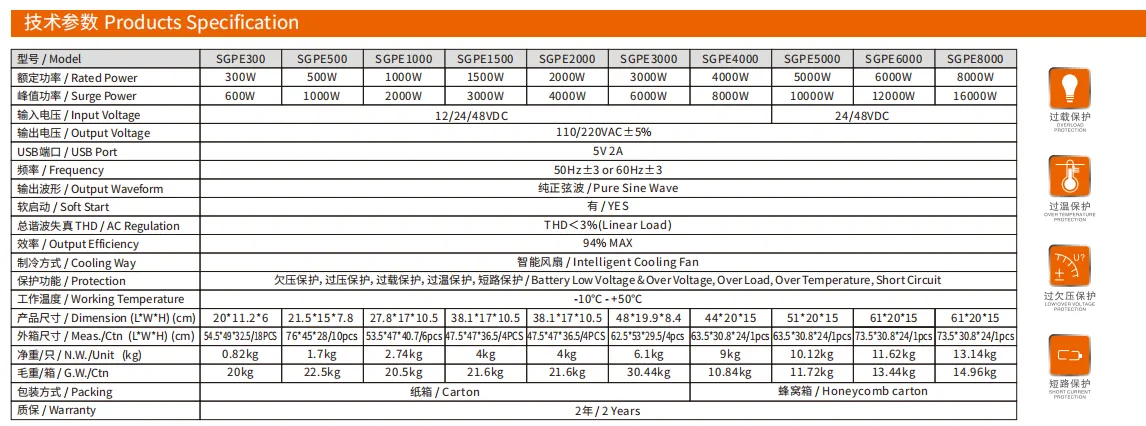Affordable Prices for 3kW Solar Inverters and Their Impact on Renewable Energy Adoption
Understanding the Price of 3kW Solar Inverters
The push towards renewable energy and sustainability has made solar power an increasingly popular choice for both residential and commercial installations. Among the various components that make up a solar system, the inverter plays a crucial role. It converts the direct current (DC) generated by solar panels into alternating current (AC), which can be used by household appliances and fed into the grid. This article delves into the price of a 3kW solar inverter and the factors influencing its cost.
What is a 3kW Solar Inverter?
A 3kW solar inverter is designed to handle a maximum output of 3 kilowatts, making it suitable for small to medium-sized solar power systems, typically ranging from 3kW to 4kW in total capacity. It is ideal for residential setups, especially for homes that consume moderate energy during the day when solar production is at its peak. Choosing the right inverter is critical for ensuring the efficiency and effectiveness of a solar energy system.
Price Range of 3kW Solar Inverters
The price of a 3kW solar inverter can vary significantly based on several factors, including brand, technology (string vs. microinverters), and additional features like monitoring capabilities and warranties. On average, a 3kW inverter can cost anywhere from $800 to $2,500.
- Basic Models Entry-level models may start around $800 to $1,200. These often lack advanced features but can get the job done efficiently. - Mid-Range Inverters Models priced between $1,200 and $1,800 usually offer better efficiency ratings, longer warranties, and improved durability. - High-End Options Premium inverters can cost $1,800 and above. These products often include smart technology, such as real-time monitoring and compatibility with home energy management systems, enabling homeowners to optimize energy consumption.
Factors Influencing the Price
3kw solar inverter price

1. Brand Reputation Well-known brands often command higher prices due to their reliability, service, and performance track records. Investing in a trusted brand can offer peace of mind and long-term benefits.
2. Type of Inverter - String Inverters These are the most common and tend to be less expensive. They are best for installations where panels receive uniform sunlight. - Microinverters While they are typically more costly, microinverters allow for better performance in shaded or complex installations since each panel operates independently.
3. Features and Technology Inverters with advanced features, such as integrated monitoring or grid support capabilities, generally come at a premium. These features allow users to monitor performance and make necessary adjustments to optimize energy usage.
4. Installation Costs While not directly related to the inverter itself, the cost of installation can influence the overall project budget. Depending on the complexity of the installation and local labor rates, installation costs can significantly impact the total investment.
5. Incentives and Rebates Government incentives, tax credits, and rebates for solar installations can offset some of the costs. Depending on your location, it is advisable to research available programs that may apply.
Conclusion
Investing in a 3kW solar inverter is a significant step towards harnessing solar energy for residential use. While prices can vary widely, understanding the factors that influence them can help potential buyers make informed decisions. The right inverter not only enhances the efficiency of a solar system but also provides a reliable energy source that can reduce energy bills and promote sustainability. As the market continues to evolve, prices may become more competitive, providing even more opportunities for homeowners to transition to renewable energy.
-
String Solar Inverter: The High-Efficiency Solution for Smart Solar EnergyNewsJul.14,2025
-
Revolutionizing Rooftop Energy with the Power of the Micro Solar InverterNewsJul.14,2025
-
Power Independence with Smart Off Grid Solar Inverter SolutionsNewsJul.14,2025
-
On Grid Solar Inverter: Powering the Future with Smart Grid IntegrationNewsJul.14,2025
-
Monocrystalline Solar Panels: High-Efficiency Power for the Future of Clean EnergyNewsJul.14,2025
-
Bifacial Solar Panel: A Smarter Investment for Next-Generation Energy SystemsNewsJul.14,2025







